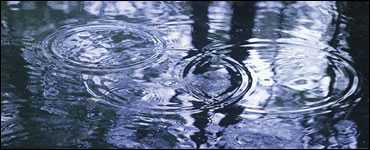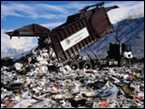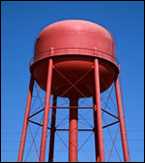NOTICE: This web page has been archived for historical purposes. Its content is no longer maintained, so information may be out of date and links may not work properly. For current Healthy Water features, please see the Newsroom, Features, & Observances page.
Ground Water Awareness Week 2008

Tap Water - Where Does It Come From and Is It Safe to Drink?
Safe drinking water is essential to good health and quality of life. Therefore, protecting water sources from contamination is a major concern.
 Water is one of our most valuable resources. Water covers about 70% of the Earth's surface and is one of the most important resources needed for maintaining life 1. In 2000, the United States alone used 408 billion gallons of water per day 2! Ground water, which is obtained by drilling wells, is water located below the ground surface in pores and spaces in the rock, and is used by approximately 40%–45% of the US population as its drinking water supply 3–5. People use ground water every day for a variety of reasons, including drinking, recreation, agriculture, and industry. Most of the time this water is completely safe and not a cause for worry. However, during 2003 and 2004, 30 waterborne-disease outbreaks related to drinking water were reported to CDC. These outbreaks resulted in 2,760 cases of illness and 4 deaths. Seven of these outbreaks (23%) and 1,830 cases of illness could be attributed to improperly treated or untreated ground water used for drinking purposes; two of these outbreaks involved private wells 6.
Water is one of our most valuable resources. Water covers about 70% of the Earth's surface and is one of the most important resources needed for maintaining life 1. In 2000, the United States alone used 408 billion gallons of water per day 2! Ground water, which is obtained by drilling wells, is water located below the ground surface in pores and spaces in the rock, and is used by approximately 40%–45% of the US population as its drinking water supply 3–5. People use ground water every day for a variety of reasons, including drinking, recreation, agriculture, and industry. Most of the time this water is completely safe and not a cause for worry. However, during 2003 and 2004, 30 waterborne-disease outbreaks related to drinking water were reported to CDC. These outbreaks resulted in 2,760 cases of illness and 4 deaths. Seven of these outbreaks (23%) and 1,830 cases of illness could be attributed to improperly treated or untreated ground water used for drinking purposes; two of these outbreaks involved private wells 6.
National Ground Water Awareness Week*, sponsored by the National Ground Water Association (NGWA), is March 9–15. The primary focus during this week is to stress the importance of ground water as a valuable resource and to focus attention on yearly water testing and well maintenance to prevent waterborne illness.
Ground Water and Pollution
 Drinking water supplies in the United States are among the safest in the world. However, even in the U.S., drinking water sources can become contaminated, causing sickness and disease. Ground water can become unusable if it becomes polluted and is no longer safe to drink. Certain contaminants, such as arsenic and radon, can occur naturally in the environment and their concentration in ground water depends highly on the geology of the land around the water source. Other ground water contaminants are the result of local land use practices (fertilizers and pesticides), microbial contamination, manufacturing processes, and problems with the integrity of nearby onsite septic systems. For example, nitrate contamination of ground water may occur as a result of nitrate-containing fertilizer used in agricultural areas, fecal contamination from feedlots, and leaking onsite wastewater systems contaminating the ground water source.
Drinking water supplies in the United States are among the safest in the world. However, even in the U.S., drinking water sources can become contaminated, causing sickness and disease. Ground water can become unusable if it becomes polluted and is no longer safe to drink. Certain contaminants, such as arsenic and radon, can occur naturally in the environment and their concentration in ground water depends highly on the geology of the land around the water source. Other ground water contaminants are the result of local land use practices (fertilizers and pesticides), microbial contamination, manufacturing processes, and problems with the integrity of nearby onsite septic systems. For example, nitrate contamination of ground water may occur as a result of nitrate-containing fertilizer used in agricultural areas, fecal contamination from feedlots, and leaking onsite wastewater systems contaminating the ground water source.
The presence of these toxic substances in our water can lead to health issues, including gastrointestinal illness, reproductive problems, and neurological disorders. Infants, young children, pregnant women, the elderly, and people whose immune systems are compromised because of AIDS, chemotherapy, or transplant medications, may be especially susceptible to illness from some contaminants. The U.S. Environmental Protection Agency (EPA) sets maximum concentration levels for many water pollutants and chemicals and regulates drinking water quality in public water systems. With careful use and by reducing sources of pollution, ground water can continue to be an important natural resource in the future.
For More Information on Ground Water and Pollution
- EPA - Water Pollution
- Water Health Connection - Recognizing Waterborne Disease and the Health Effects of Water Pollution (Clinicians)*
- EPA - Surf Your Watershed
Community or Municipal Water System
If you get your tap water from a system that uses ground water, your water could come from a community/municipal water system or a private ground water well.
 In 2005, 89.5 million Americans got their tap water from a community or municipal water system that used ground water 7. EPA has laws that regulate the levels of contaminants allowed in drinking water supplied by public water systems, such as public water utility companies. More information about these laws can be found on EPA's National Primary Drinking Water Regulations Web page. Every water utility company is required to provide Consumer Confidence Reports (CCR) to their customers each year. This report provides information on local drinking water quality, including the water's source, the contaminants and levels found in the water, and how customers can get involved in protecting their drinking water.
In 2005, 89.5 million Americans got their tap water from a community or municipal water system that used ground water 7. EPA has laws that regulate the levels of contaminants allowed in drinking water supplied by public water systems, such as public water utility companies. More information about these laws can be found on EPA's National Primary Drinking Water Regulations Web page. Every water utility company is required to provide Consumer Confidence Reports (CCR) to their customers each year. This report provides information on local drinking water quality, including the water's source, the contaminants and levels found in the water, and how customers can get involved in protecting their drinking water.
For More Information on Public Drinking Water Quality and Your Local Drinking Water CCR
- EPA – Public Drinking Water System Programs
- EPA – Local Drinking Water Information
- EPA – Consumer Confidence Reports (CCR)
- EPA – What Contaminants May Be Found in Drinking Water?
- EPA - Drinking Water Standards
- EPA Water Quality
Private Ground Water Well
Spring is a great time to have your well water tested, before the beginning of peak water-use season! Between 40 and 45 million Americans regularly depend on private ground water wells 8–9. EPA rules that protect public drinking water systems do not apply to privately owned wells. Private well owners are responsible for ensuring their well water is safe from contaminants of health concern. See the box for rules to help ensure safe drinking water from your well.
For More Information on Ground Water Quality, Well Maintenance, and Well Water Testing
What CDC Is Doing
CDC has initiated prevention activities to help protect public health and prevent diseases associated with exposures to drinking water contaminants. Activities include:
- Investigating the health effects of exposure to contaminants in ground water
- Investigating drinking water exposures among households without access to potable water
- Collaborating on investigations of the impact of household water filtration systems on public health
- Tracking waterborne disease outbreaks at the national level
- Providing recommendations on how to prevent waterborne disease
- Evaluating community-level interventions to reduce drinking water contamination
Every homeowner with a private well should know these simple rules to ensure safe drinking water
- Wells should be checked and tested annually for mechanical problems, cleanliness, and the presence of certain contaminants, such as coliform bacteria, nitrates/nitrites, and any other contaminants of local concern, such as arsenic and radon.
- Well water should be tested more than once a year if there are recurrent incidents of gastrointestinal illness among household members and/or a change in taste, odor, or appearance of the well water.
- All hazardous materials, such as paint, fertilizer, pesticides, and motor oil, should be kept far away from your well.
- When mixing chemicals, do not put the hose inside the mixing container, as this can siphon chemicals into a household's water system.
- Consult a professional contractor to verify that there is proper separation between your well, home, waste systems, and chemical storage facilities.
- Always check the well cover or well cap to ensure it is intact. The top of the well should be at least one foot above the ground.
- Once your well has reached its serviceable life (usually more than 20 years), have a licensed or certified water well driller and pump installer decommission the existing well and construct a new well.
For additional information about these activities, see:
- Surveillance for Waterborne Disease and Outbreaks Associated with Drinking Water and Water not Intended for Drinking – United States, 2003-2004
- Outbreak Investigation of Gastrointestinal Illness Associated with Contaminated Ground Water on South Bass Island
- Clinical Infectious Diseases Journal Article
- Ohio Department of Health Summary
- Notice to Readers: Ground Water Awareness Week---March 9--15, 2008 MMWR, March 7, 2008: 57(09); 236-7.
- CDC - Water-Related Environmental Public Health
- CDC - Chemical Contaminants in Drinking Water and Public Health
- CDC - Index of Water-Related Topics
For More Information
Ground water in general
References
- USGS. How much water is there on, in, and above Earth?
- USGS. Estimated Use of Water in the United States in 2000.
- US Census Bureau. Annual estimates of the population for the United States, regions, and states and for Puerto Rico: April 1, 2000 to July 1, 2007 (NST-EST2007-01).
- US Environmental Protection Agency. Private drinking water wells.
- US Environmental Protection Agency. Factoids: Drinking Water and Ground Water Statistics for 2005. Available at http://water.epa.gov/drink/index.cfm.
- CDC. MMWR - Surveillance for Waterborne Disease and Outbreaks Associated with Drinking Water and Water not Intended for Drinking --- United States, 2003--2004. Available at http://www.cdc.gov/mmwr/preview/mmwrhtml/ss5512a4.htm.
- US Environmental Protection Agency. Factoids: Drinking Water and Ground Water Statistics for 2005. Available at http://water.epa.gov/drink/index.cfm.
- US Environmental Protection Agency. Private Drinking Water Wells. Available at http://www.epa.gov/safewater/privatewells/index2.html.
- U.S. Census Bureau. National and State Population Estimates.
Get email updates
To receive email updates about this page, enter your email address:
Contact Us:
- Centers for Disease Control and Prevention
1600 Clifton Rd
Atlanta, GA 30333 - 800-CDC-INFO
(800-232-4636)
TTY: (888) 232-6348 - Contact CDC–INFO
 ShareCompartir
ShareCompartir


